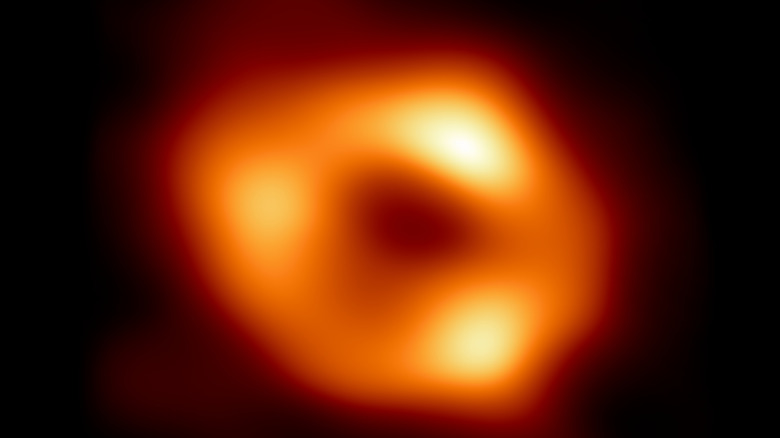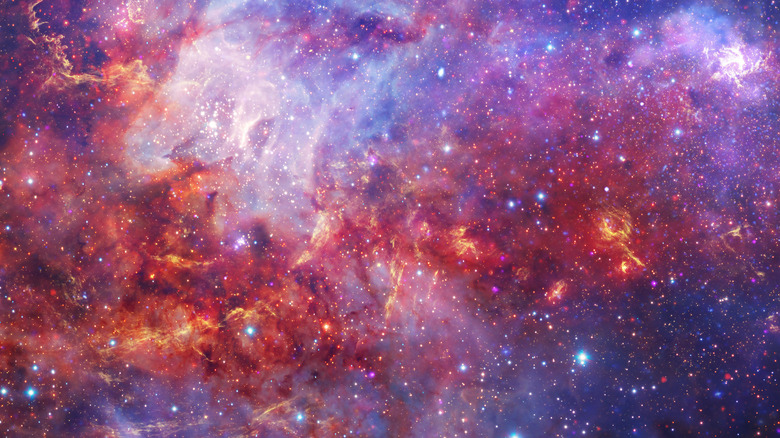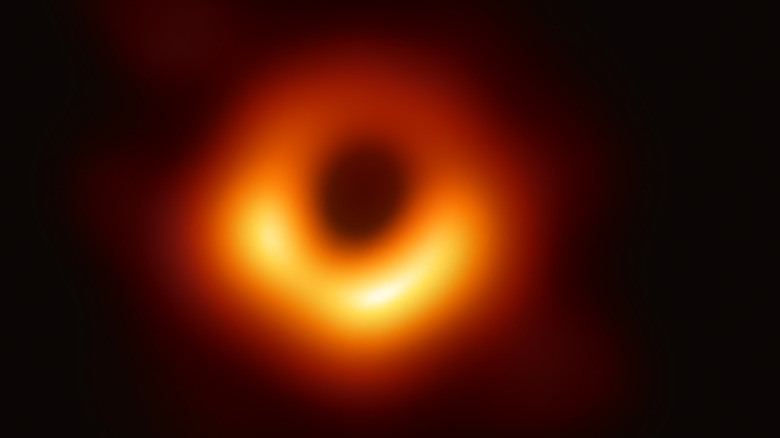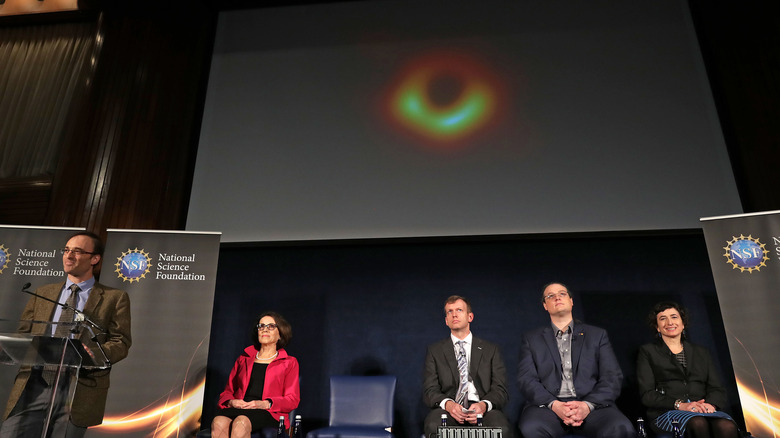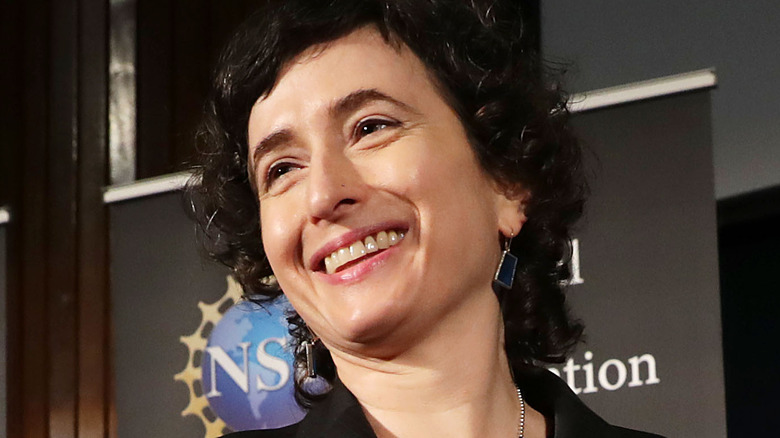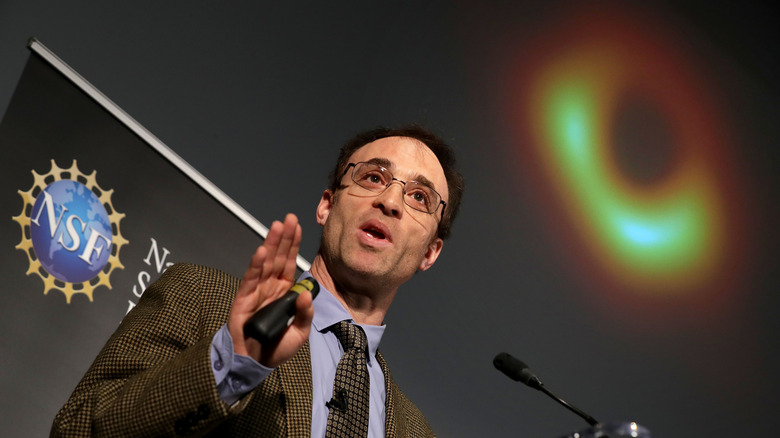Scientists Share Jaw Dropping First Photos Of The Black Hole In The Milky Way
In early May, scientists from the National Science Foundation and several other affiliated international agencies made a major announcement: The first-ever picture of a black hole within our own galaxy was captured (via Insider). One other picture of a black hole, dubbed M87, was taken in 2019, but this nearby black hole, called Sagittarius A* (pronounce it "Sagittarius A-Star," per Forbes) is very different in several important respects. For scale, the previously pictured black hole, M87, is about 55 million light years from Earth, as Britannica notes, while Sagittarius A* (Sgr A*) is much closer, at only about 26,000 light years, according to NASA.
This amazing scientific development offers fresh insight into these mysterious galactic phenomena. From how such an amazing image was even captured to what further study and even more detailed image gathering might one day reveal, here's a closer look at the first-ever photos of a black hole taken from within our galaxy, the Milky Way.
What is a black hole?
Black holes, such as the first two to ever be photographed, M87 and Sagittarius A*, are areas of space where the gravitational pull is so strong that nothing escapes, not even light. Sometimes created when a star dies, that pull is so strong because a large amount of mass is packed into a very small space. Black holes can vary in size. Some may be as small as an atom, while others can reach the size of a mountain, if not larger. There are also many different types of black holes, formed for a number of different reasons, according to NASA.
What makes the photography of black holes all that much more impressive is that black holes are black — as in, they can't be seen. So how do we even know that they're there? It's when the gravitational pull is detected that we know a black hole may be present. Einstein's Theory of Relativity also plays a part. Some black holes may have first formed at the same time as the galaxy. Black holes do eat planets and stars that stray too close, but NASA assures us that no black hole is close enough to the Earth for that to happen to us.
The first black hole image from 2019
The first black hole ever photographed is commonly called M87 or Messier 87, Virgo A, or NGC4486 (that last one is catchy). M87 is also one of the largest black holes so far encountered, sitting at the center of what astronomers call the Virgo Cluster, a dense mass of galaxies millions of light years from Earth. Radiating from M87 are powerful waves of radiation, X-ray energy, and gas. Otherwise, M87 is more than 6 billion times the mass of the sun, and roughly 24 billion miles across, via Britannica.
Compare that to our own sun, with a diameter of about 865,000 miles, and M87 is quite large indeed, much larger than be comprehended on an Earthly scale. At the time that images of M87 were released, Heino Falcke, a Dutch scientists involved with the Event Horizon Telescope (EHT) project responsible for capturing images of M87 and now Sagittarius A*, told Science that seeing a black hole "feels like looking at the gates of hell ... This is the end of space and time."
How images of black holes are captured
M87 and Sagittarius A* were both photographed in a similar fashion, using the Event Horizon Telescope, or EHT. Through a global daisy chain of high-powered telescopes, the Earth itself is transformed into something like one giant viewing device, according to Forbes. This added power lets scientists zoom in close enough to see where the immense amount of gravitational pull produced by a black hole accelerates matter, bending the path of photons.
This effect, more than the black holes itself, is what's captured in pictures. Averaging each image produced by EHT, pictures of black holes are produced. Of the new Sagittarius A* imagery, EHT project scientist Geoffrey Bower said in a statement (via Palm Springs news outlet KESQ), "These unprecedented observations have greatly improved our understanding of what happens at the very [center] of our galaxy, and offer new insights on how these giant black holes interact with their surroundings."
How images of M87 and Sgr A* compare
In addition to size and relative distance from Earth, the new pictures of Sagittarius A* captured by EHT are different from the previously captured image of M87 in some respects, and similar in many others. Because of their size, we can now see how gas orbits black holes differently. The orbit is much shorter around Sgr A*. The speed at which gas moves around a black holes appears to be similar, though. Differences aside, other similarities about the two black holes so far pictured also excite scientists, according to Forbes.
As EHT scientist Sera Markoff (above) said (via Forbes), between the two pictures, "We have two completely different types of galaxies and two very different black hole masses." Otherwise, though, the pictures look remarkably similar. "This tells us that [Einstein's theory of] General Relativity governs these objects up close," and the differences seen between M87 and Sgr A* "must be due to differences in the material that surrounds the black holes."
What can we learn about Sagittarius A* from these pictures?
Now that images of Sgr A* are captured, scientists' work will continue, using data and measurements gathered to test and substantiate the physics of black holes in a non-theoretical environment, per BBC. With added information from infrared instruments on a soon-to-be-added new high-powered orbiting telescope called James Webb, who knows what we might find out next, particularly in terms of how stars behave close to the event horizon, or the surface of a black hole from which nothing can escape (via Merriam-Webster).
As James Webb scientist Dr. Jessica Lu told BBC, "Every time we get a new facility that can take a sharper image of the Universe, we do our best to train it on the galactic center, and we inevitably learn something fantastic." The Sgr A* images were revealed at a European Southern Observatory (ESO) press conference and other events held simultaneously around the world. These events came after nearly two weeks of speculation as to what the ESO had discovered (via Forbes).
